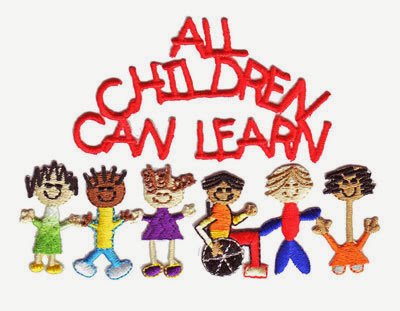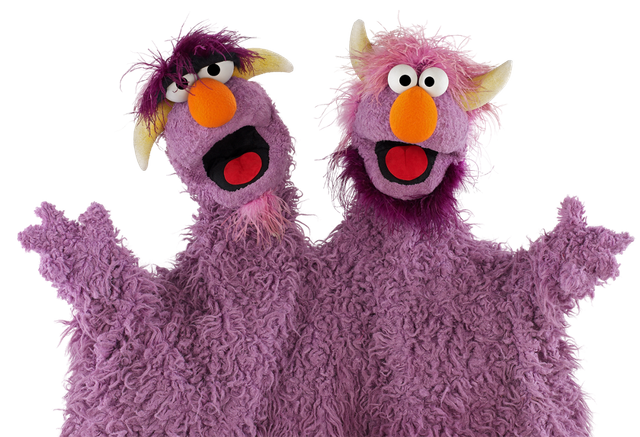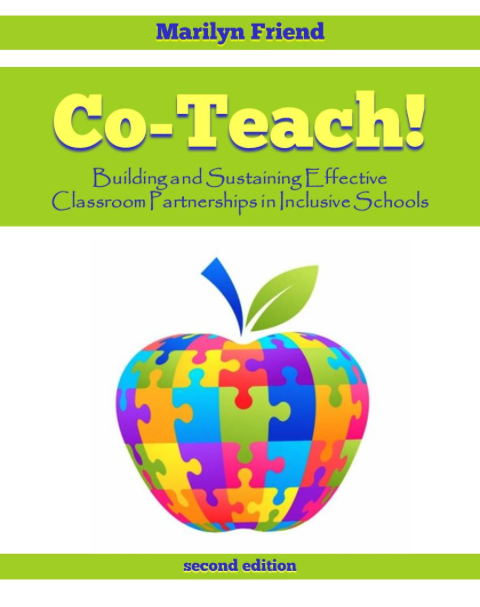Two heads are better than one: Co-teaching in the high school classroom.
Most of you know me as a weird geek who is obsessed with Star Wars, looking for life lessons in pop culture, taking his kids to movies and making fun of himself (or you don't know me at all and you are like, "Who is this goof?").
But I am also a high school special education teacher.

Actually I'd prefer if this said "all people".
Earlier this summer, I was lucky enough to attend an educational workshop run by one of my personal heroes, Dr. Marilyn Friend.
Dr. Friend is the Chairperson and Professor of Education in the Department of Specialized Education Services at the University of North Carolina at Greensboro. She is also currently serving on the Board of the Teacher Education Division of the Council for Exceptional Children, an organization dedicated to advocating for the rights of and best teaching practices for students with disabilities. Before serving on the board, Dr. Friend was the President of the C.E.C. She is an educational consultant who has conducted more than 1000 workshops in the United States, Canada, Europe, and Asia.
Although that is all quite impressive, I know her as the godmother of co-teaching.
According to Dr. Friend, co-teaching is an educational delivery model which "offers options to enable students with disabilities to reach their potential by providing them with access to the general education curriculum while ensuring they receive the specially designed instruction to which they are entitled." The model involves two or more educators with equivalent licensure working side by side and sharing responsibility for the education of all students in a classroom.
According to me, co-teaching is a way to ensure that all students have an opportunity to benefit from an excellent education. It is a way to help every student to help themselves reach their full potential. It is a way for a school and community to demonstrate that it values and believes that all students can succeed. Co-teaching is what I would want my child to have access to if he or she had a disability.

Two heads are better than one!
This model allows for students with disabilities to be educated along side their peers without disabilities instead of being isolated from them in a separate setting with a different teacher. Not only does this model fulfill the spirit of the special education laws in the United States which dictate that a student should be educated in the "least restrictive environment", it also provides students with disabilities equal access to the social and educational benefits their peers receive.
Although there are some exceptions involving students whose needs are so intense that they would not be able to be met in a heterogeneous environment, for the majority of students with disabilities, co-teaching levels the playing field for them.
This is extremely important considering the vast majority of students with special needs have average to above average intelligence. For example, a student may have a disability which interferes with her ability to write a written argument, but she can dominate any verbal debate. She can also learn skills that will help her to improve her written expression.
This leveling of the field is the true goal and benefit of co-teaching. The idea is not to require the students to do less, it is to use more and different techniques to ensure that the students can access the same curriculum as their peers. By having two educators in the classroom, these "more and different" interventions can be effectively implemented.

No Bart. We are going to catch up by using more and different techniques that match your needs.
Co-teaching is a way to make sure that all students arrive at the same destination... even if they have to take different roads to get there.
Once in the classroom, co-teaching can take many shapes. This flexibility is one of the most beautiful things about co-teaching. The approach can change in order to meet students' individual needs on any given day.
The following are five possible co-teaching approaches. I have listed them in the order of how frequently I believe each should be used in a high school co-taught classroom.

This diagram is not numbered in order of frequency. My list below is.
1. Station teaching.
This is my favorite approach. It involves the two teachers dividing students and content. Each teacher teaches a specific part of the lesson. Usually this approach involves three stations. Two of the stations are teacher lead while the third is independent.
2. Alternative teaching.
This approach along with parallel teaching are tied for my second favorite approaches. In this approach, one teacher teaches to a larger group while the seance teacher provides specialized instruction to a smaller group. This allows the second teacher to teach things differently and provide more support to the smaller group. I especially like this approach because in this one, the smaller group could be students with special needs or it could be a group of more advanced students who were able to move faster and deeper into the lesson or topic. Either teacher could provide this supplemental material/instruction.
3. Parallel teaching.
In some cases, student learning could be enhanced merely by learning in a smaller group which would allow more direct instructor contact with each student. Parallel teaching provides this opportunity by splitting the class into two equal ha;ver with each teacher facilitating the same lesson. In this case, both groups could be completely heterogeneous. Either teacher could teach either group.
4. Teaming.
In this approach both teachers deliver the same instruction at the same time. This approach can be very effective if it has a specific intended purpose. For example, if teachers were instructing students on prefixes and suffixes, one teacher could wear prefixes on the front of their shirt while the other wore suffixes on their back. Each teacher could facilitate part of the lesson. However if this merely turned into one teacher repeating or rephrasing the other teacher, then this is very inefficient. In effect, there are two people who are doing the job of one teacher. Although this method typically does not meet the test of providing "more and different" instruction, it can be effective in certain situations.
5. One teach, one assist.
This method looks more like a lead teacher being assisted by a teacher aide or para-educator. The lead teacher would facilitate a lesson while the other teacher circulated through the room providing one on one assistance "on the fly". Although the stay be effective fro some material, if it is overused, it can become very distracting not only for the student receiving the intervention but also for the surrounding students. This also creates a situation where both teachers do not appear to be equal partners in the classroom. If this approach is used, it may be necessary to alternate the roles between the two teachers.
6. One teach, one observe.
This approach would only be used if the team needed to collect data on one or several students. This could be very beneficial if a student has a specific plan to address his or her behaviors. It could also help in writing data based goals for a student's individualized education plan. Although this model definitely has value, it should not be the dominant approach in a co-taught classroom.

In my next education related piece, I will delve deeper into my favorite approach: station teaching.
But before then, I'll probably write something a little lighter. Maybe I'll just ask my wife to tell me something stupid that I have done recently and I'll write about that...
Yep. She said she already has a list.
For those of you interested in supporting educational posts on steemit, please check out @steemiteductaion. @steemiteducation resteems at least 10 high quality education related posts each day. If you go to the blog, you can see the daily selections.
If you don't know what @steemiteducation is all about, please check out the following video.
For more information about co-teaching, please visit http://www.marilynfriend.com.
Great article and imagery.
improved thinking
In my high school they had the special education kids take classes along side the kids without disabilities. But they also had one special class period for the special education kids where two teachers who specialized in special ed. taught the students to make sure they understood the material taught in all their classes. The two teachers alternated between station teaching and one teach one assist. I had really great grades my senior year so I was allowed to be a peer tutor where that one class had me sitting down with other kids my age to help them with their work. So they had two teachers and a tutor all working together. I think that model really helped because you had the two experts able to give more students one on one attention plus a student tutor their own age. Some of the special education students relaxed a bit more with me because of my age.
Wow! This is music to my ears. I love that the teachers got you involved. I guarantee you the kids learned more form you than any adult in that room. And I don't just mean about the lesson. They learned about treaty others with dignity and respect. I bet a lot of other kids in the class learned a lot from your example as well.
highly motivated, a very valuable lesson
Great educational post!
Thanks for sharing
Nice post on education. Thanks for sharing.
I agree. Every educator should at least know about this.
Thanks!
@hanshotfirst - This is a great post, which I hope reaches far and wide. I completely agree with what you are saying:
I am very fortunate to be able to say that my sons school is very inclusive in this respect. They have at least one or two special needs kids in every class in their school and they are taught in the same class by the same teachers. They have their personal facilitators alongside them too.
Personally I think it is not only important that children with special needs be afforded the opportunity to integrate in normal society, but also for the children that do not have any special needs to be exposed to them too, as it teaches them not to be cruel. It teaches them to accept them just like everyone else and that is VERY important too!
Great post as usual!
"but also for the children that do not have any special needs to be exposed to them too"
Exactly!!!! Kids can learn so much from their peers with special needs!
yip! True Story :)
Wow @hanshotfirst. What a novel idea to deal with the discrimination our society imposes upon special needs children. They deserve all off that and more of what a normal child deserves. This 2 teacher practice can go a long way for improving situation for them. Indeed two heads are double the fun and double the attention on kids.
You are preaching to the choir. And what people need to remember is that people with disability is one of the few minority groups that a person can become during any time in their life. One traumatic brain injury or illness and we could all be part of this group. Probably should start treating them better...
No doubt about it. Anyone can can be a part of it.
I genuinely didn't know there were so many different techniques to it. I am awfully interested given that my daughter will be starting in school next year.
And on the subject of lighter approaches...
Lol! I used to teach that until "the incident". A bunch of kids went dark side on me. It wasn't good.
Ah well we can't have that. Steer clear! :0)
Wooooohhhh!!! Laser sword!!!!!!!!!!!!!!!!!!!!!!!!!!!!!!!!!! haha
:0) my speciality
lol that is funny.. ahahha
:0)
I think it was more funny due to the seriousness of the post. After reading the article, thinking that could be a great idea and I was seriously going to ask my primary school teacher of a sister, what she thinks about it. I then scrolled down and saw your face with a lightsaber shouting "teach this!".... love your animations btw...
Lol, I have always loved photoshopping lightsabres onto pics. I knew hanshotfirst would like a bit of Sabre action!
Always!
I was a systems analyst for 10 years.... then I started working at this restaurant. I went back to school to get an associates degree in teaching.
Since all I ever needed to become a systems analyst were a bunch of computer certificates, I had no degree at all when I got laid off. I was able to get my associates in Spanish with a teaching ESL addendum. My plan was to teach ESL or start as a TA.
The only positions that I was able to find were for special ed teachers assistants and all of them required you to change student's diapers. Change grown adult student's diapers.
I don't want to do that so it was really disheartening because I spent several years and my own money barely getting by working in this restaurant to go back to school to get that degree and finding out that the only position they want to hire me for is a diaper changer.
Now I am still at this restaurant..... 11 years now. I still read posts like these and enjoy them because I still see myself as a teacher. I just feel like I got lost in the system somehow along the way.
I didn't realize you had teaching education! That's a shame you couldn't find a job. Times change and education is different than it was 11 years ago. Have you thought about pursuing it again? There are other areas other than teaching. With Spanish and ESL you could work for a lot of organizations teaching English as a second language. Maybe even government jobs. I did online tutoring for extra cash and there are always jobs for people with ESL experience.
Well. I can speak Spanish and write Spanish. I did spend about 2 to 3 years doing a total immersion experience where I only spoke Spanish. I live in Texas so it's not hard to find some people that are always willing to speak Spanish with you everyday. It's hard though when you work 7 days a week because you come home tired and it's difficult to continue to try. I am still looking for teaching assistant jobs but it is difficult.
I understand. I am very happy that many of my colleagues have a calling to help the students with the most sever disabilities. It is incredibly difficult. If you don't have that calling you did the right thing to not take ea job that you would resent. I truly hope you are able to find a teaching job. You sound very passionate about it. What about teaching the skills needed to be a systems analyst?
This is a compleete new way and I think it will help a lot to make the school better. It should be a test phase going on, to see how it will affect the teaching power. Thanks for sharing, upvoted 100% for that great idea
Very good article. I know the pain of parents with special kids, one of my friend's son is autistic and it is nearly impossible for him to get admission into regular school and its hurtful to see all kids with similar disability issues have to go special schools. This way they never be treated with regulars and practically robbing them to grow naturally.